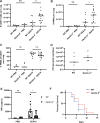The C-Type Lectin Receptor Dectin-2 Is a Receptor for Aspergillus fumigatus Galactomannan
- PMID: 36598192
- PMCID: PMC9973300
- DOI: 10.1128/mbio.03184-22
The C-Type Lectin Receptor Dectin-2 Is a Receptor for Aspergillus fumigatus Galactomannan
Abstract
Aspergillus fumigatus is a ubiquitous environmental mold that causes significant mortality particularly among immunocompromised patients. The detection of the Aspergillus-derived carbohydrate galactomannan in patient serum and bronchoalveolar lavage fluid is the major biomarker used to detect A. fumigatus infection in clinical medicine. Despite the clinical relevance of this carbohydrate, we lack a fundamental understanding of how galactomannan is recognized by the immune system and its consequences. Galactomannan is composed of a linear mannan backbone with galactofuranose sidechains and is found both attached to the cell surface of Aspergillus and as a soluble carbohydrate in the extracellular milieu. In this study, we utilized fungal-like particles composed of highly purified Aspergillus galactomannan to identify a C-type lectin host receptor for this fungal carbohydrate. We identified a novel and specific interaction between Aspergillus galactomannan and the C-type lectin receptor Dectin-2. We demonstrate that galactomannan bound to Dectin-2 and induced Dectin-2-dependent signaling, including activation of spleen tyrosine kinase, gene transcription, and tumor necrosis factor alpha (TNF-α) production. Deficiency of Dectin-2 increased immune cell recruitment to the lungs but was dispensable for survival in a mouse model of pulmonary aspergillosis. Our results identify a novel interaction between galactomannan and Dectin-2 and demonstrate that Dectin-2 is a receptor for galactomannan, which leads to a proinflammatory immune response in the lung. IMPORTANCE Aspergillus fumigatus is a fungal pathogen that causes serious and often fatal disease in humans. The surface of Aspergillus is composed of complex sugar molecules. Recognition of these carbohydrates by immune cells by carbohydrate lectin receptors can lead to clearance of the infection or, in some cases, benefit the fungus by dampening the host response. Galactomannan is a carbohydrate that is part of the cell surface of Aspergillus but is also released during infection and is found in patient lungs as well as their bloodstreams. The significance of our research is that we have identified Dectin-2 as a mammalian immune cell receptor that recognizes, binds, and signals in response to galactomannan. These results enhance our understanding of how this carbohydrate interacts with the immune system at the site of infection and will lead to broader understanding of how release of galactomannan by Aspergillus effects the immune response in infected patients.
Keywords: Aspergillus fumigatus; fungi; host-pathogen interactions; immune mechanisms; innate immunity; mycology.
Conflict of interest statement
The authors declare no conflict of interest.
Figures




Similar articles
-
Activation of NF-κB and respiratory burst following Aspergillus fumigatus stimulation of macrophages.Immunobiology. 2014 Jan;219(1):25-36. doi: 10.1016/j.imbio.2013.06.013. Epub 2013 Jul 4. Immunobiology. 2014. PMID: 23886693
-
The beta-glucan receptor dectin-1 recognizes specific morphologies of Aspergillus fumigatus.PLoS Pathog. 2005 Dec;1(4):e42. doi: 10.1371/journal.ppat.0010042. Epub 2005 Dec 9. PLoS Pathog. 2005. PMID: 16344862 Free PMC article.
-
Dectin-1-dependent interleukin-22 contributes to early innate lung defense against Aspergillus fumigatus.Infect Immun. 2012 Jan;80(1):410-7. doi: 10.1128/IAI.05939-11. Epub 2011 Oct 28. Infect Immun. 2012. PMID: 22038916 Free PMC article.
-
Stage-specific innate immune recognition of Aspergillus fumigatus and modulation by echinocandin drugs.Med Mycol. 2009;47 Suppl 1(0 1):S192-8. doi: 10.1080/13693780802078131. Epub 2008 Apr 23. Med Mycol. 2009. PMID: 18608931 Free PMC article. Review.
-
Interplay of Cytokines and Chemokines in Aspergillosis.J Fungi (Basel). 2024 Mar 27;10(4):251. doi: 10.3390/jof10040251. J Fungi (Basel). 2024. PMID: 38667922 Free PMC article. Review.
Cited by
-
Manipulation of host phagocytosis by fungal pathogens and therapeutic opportunities.Nat Microbiol. 2024 Sep;9(9):2216-2231. doi: 10.1038/s41564-024-01780-0. Epub 2024 Aug 26. Nat Microbiol. 2024. PMID: 39187614 Review.
-
Recent developments in Aspergillus fumigatus research: diversity, drugs, and disease.Microbiol Mol Biol Rev. 2025 Mar 27;89(1):e0001123. doi: 10.1128/mmbr.00011-23. Epub 2025 Feb 10. Microbiol Mol Biol Rev. 2025. PMID: 39927770 Review.
-
Zebrafish use conserved CLR and TLR signaling pathways to respond to fungal PAMPs in zymosan.Dev Comp Immunol. 2025 Jan;162:105286. doi: 10.1016/j.dci.2024.105286. Epub 2024 Nov 12. Dev Comp Immunol. 2025. PMID: 39536806
-
Aspergillus fumigatus biology, immunopathogenicity and drug resistance.Nat Rev Microbiol. 2025 May 2. doi: 10.1038/s41579-025-01180-z. Online ahead of print. Nat Rev Microbiol. 2025. PMID: 40316713 Review.
-
Neutrophil extracellular traps in tumor progression and immunotherapy.Front Immunol. 2023 Mar 13;14:1135086. doi: 10.3389/fimmu.2023.1135086. eCollection 2023. Front Immunol. 2023. PMID: 36993957 Free PMC article. Review.
References
-
- Schauwvlieghe A, Rijnders BJA, Philips N, Verwijs R, Vanderbeke L, Van Tienen C, Lagrou K, Verweij PE, Van de Veerdonk FL, Gommers D, Spronk P, Bergmans D, Hoedemaekers A, Andrinopoulou ER, van den Berg C, Juffermans NP, Hodiamont CJ, Vonk AG, Depuydt P, Boelens J, Wauters J, Dutch-Belgian Mycosis Study Group . 2018. Invasive aspergillosis in patients admitted to the intensive care unit with severe influenza: a retrospective cohort study. Lancet Respir Med 6:782–792. doi:10.1016/S2213-2600(18)30274-1. - DOI - PubMed
-
- Schaffner A, Douglas H, Braude A. 1982. Selective protection against conidia by mononuclear and against mycelia by polymorphonuclear phagocytes in resistance to Aspergillus: observations on these two lines of defense in vivo and in vitro with human and mouse phagocytes. J Clin Invest 69:617–631. doi:10.1172/jci110489. - DOI - PMC - PubMed
Publication types
MeSH terms
Substances
Grants and funding
LinkOut - more resources
Full Text Sources
Molecular Biology Databases

